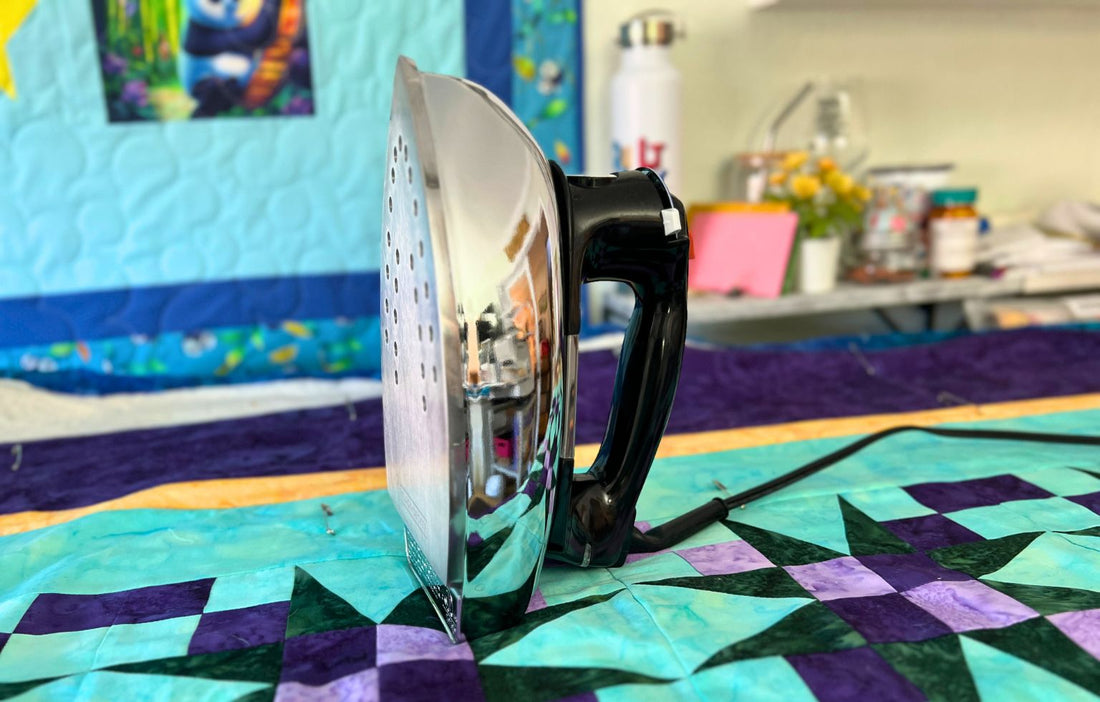
Quilting with a $30 Iron: Why Simple Sometimes Works Best
Share
If there’s one tool quilters talk about almost as much as sewing machines, it’s irons. A good press can make the difference between seams that nest beautifully and seams that fight you every step of the way. I’ve tried my fair share of irons over the years—from cordless to gravity-feed—and recently I made a switch that surprised even me.
I bought a $30 Black + Decker steam iron—and it works like a charm!
Why I Switched to a Dry Iron
Confession time: I’ve always been a terrible iron-swisher. I’d crank the steam to high, slide that iron back and forth without a care, and watch my fabric stretch and distort. I assumed that was just part of quilting. But over time, the results showed up in my blocks—too big, too small, a little wonky.

So I started a personal campaign to learn to piece correctly. I recently caught an older video from The Quilt Show featuring Shelley Scott-Tobisch and it inspired me to grab her book, Easy Precision Piecing: A New Approach to Accuracy & Organization for Quilters and finally learn to do it right. That’s where this whole iron adventure began.
Shelley is a veteran quilt instructor with 30+ years of experience and the creator of the Easy Precision Piecing System—a step-by-step approach that boosts accuracy and lowers frustration. The system focuses on:
- Organizing pieces before sewing to avoid mix-ups.
- Gentle pressing (not swishing) to keep seams square.
- Accurate cutting & consistent seam allowances for crisp results.
- Minimizing distortion by using a dry iron with no steam.
In her book, Shelley recommends a true dry iron (like the now-hard-to-find Continental Electric model) for better control. I couldn’t source one, so I adapted: I picked up an inexpensive Black + Decker steam iron where the reviews were raving about the fact that it is heavy, hot, and works perfectly without all the frills. The heat is steady, my seams are crisper, and the distortion is way down.
Explore her methods here: Easy Precision Piecing by Shelley Scott-Tobisch | Book:Easy Precision Piecing: A New Approach to Accuracy & Organization for Quilters
Choosing the Right Iron: A Quilter’s Comparison
Over the years, I’ve tested just about every type of iron. Each has pros and cons; here’s how they shake out in real quilting life:
| Type of Iron | Pros | Cons | Best For |
|---|---|---|---|
| Cordless Irons | Easy to maneuver; no cord snagging your fabric | Heat doesn’t last long; may not get as hot | Small projects, travel, light pressing |
| Gravity-Feed Irons | Very hot; steady steam; professional feel | Bulky; external tank; can “spit”; learning curve | Heavy pressing, tailoring, advanced users |
| High-End Steam Irons | Feature-rich (auto shut-off, fabric presets, steam bursts) | Expensive; more parts that can fail; occasional spitting | Everyday sewing; tech lovers |
| Dry Irons | Simple; consistent heat; no water issues | Harder to find; no steam option when you want it | Precision piecing; accuracy-focused sewing |
| Budget Corded Irons (like my $30 pick) | Affordable; heats quickly; consistent | No frills; not glamorous | Everyday piecing; reliable basics |
Cordless Convenience vs. Heat Power
I’ve loved my Panasonic cordless for years—cord-free pressing is a dream (nothing tugging mid-press!). But for me, the trade-off was heat: it never felt quite hot enough for stubborn seams. The $30 iron heats quickly, holds steady, and gives me the crisp results I’ve been after.
My Past Iron Misadventures
I’ve tried the irons that promised the world: motion sensors, auto shut-off logic, fabric-specific heat settings, elaborate steam systems—you name it. On paper, they’re impressive; in practice, more features meant more chances for issues.
Case in point: a gravity-feed iron I received as a gift. It was wonderful at first, then turned into spit-central. Despite cleaning and tinkering, it never stopped spitting. There’s nothing worse than pressing a perfect block and leaving water puddles behind.
Quilting (and Life) Lesson: Simple Works
That’s what brought me here: to a no-frills, under-$30 iron that just presses. It doesn’t spit, it doesn’t underheat, it doesn’t try to think for me. And honestly? I think I love it more than any iron I’ve owned.
Sometimes, in quilting as in life, the older, simpler, and yes—even cheaper—things really do work best.
Let’s Share
What’s your favorite iron for quilting? Have you found a hidden gem, or do you swear by a high-tech model? Share your pick (and why) in the comments—let’s help each other out.
Happy Quilting!
- Christine
